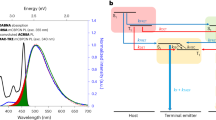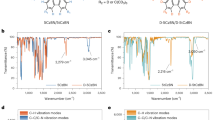Abstract
Organic light-emitting diodes (OLEDs) are a promising light-source technology for future generations of display1,2. Despite great progress3,4,5,6,7,8,9,10,11,12, it is still challenging to produce blue OLEDs with sufficient colour purity, lifetime and efficiency for applications. Here, we report pure-blue (Commission Internationale de l’ Eclairage (CIE) coordinates of 0.13, 0.16) OLEDs with high efficiency (external quantum efficiency of 32 per cent at 1,000 cd m−2), narrow emission (full-width at half-maximum of 19 nm) and good stability (95% of the initial luminacnce (LT95) of 18 hours at an initial luminance of 1,000 cd m−2). The design is based on a two-unit stacked tandem hyperfluorescence OLED with improved singlet-excited-state energy transfer from a sky-blue assistant dopant exhibiting thermally activated delayed fluorescence (TADF) called hetero-donor-type TADF(HDT-1) to a pure-blue emitter. With stricter control of device fabrication and procedures it is expected that device lifetimes will further improve to rival commercial fluorescent blue OLEDs.
This is a preview of subscription content, access via your institution
Access options
Access Nature and 54 other Nature Portfolio journals
Get Nature+, our best-value online-access subscription
$29.99 / 30 days
cancel any time
Subscribe to this journal
Receive 12 print issues and online access
$209.00 per year
only $17.42 per issue
Buy this article
- Purchase on Springer Link
- Instant access to full article PDF
Prices may be subject to local taxes which are calculated during checkout



Similar content being viewed by others

Data availability
The data that support the plots within this paper and other findings of this study are available from the corresponding author upon reasonable request.
Change history
01 March 2021
A Correction to this paper has been published: https://doi.org/10.1038/s41566-021-00759-1
References
Sekitani, T. et al. Stretchable active-matrix organic light-emitting diode display using printable elastic conductors. Nat. Mater. 8, 494–499 (2009).
White, M. S. et al. Ultrathin, highly flexible and stretchable PLEDs. Nat. Photon. 7, 811–816 (2013).
Baldo, M. A. et al. Highly efficient phosphorescent emission from organic electroluminescent devices. Nature 395, 151–154 (1998).
Kuei, C.-Y. et al. Bis-tridentate Ir(III) complexes with nearly unitary RGB efficiency exceeding 31%. Adv. Mater. 28, 2795–2800 (2016).
Kim, K. H., Ahn, E. S., Huh, J. S., Kim, Y. H. & Kim, J. J. Design of heteroleptic Ir complexes with horizontal emitting dipoles for highly efficient organic light-emitting diodes with an external quantum efficiency of 38%. Chem. Mater. 28, 7505–7510 (2016).
Uoyama, H., Goushi, K., Shizu, K., Nomura, H. & Adachi, C. Highly efficient organic light-emitting diodes from delayed fluorescence. Nature 492, 234–238 (2012).
Hirata, S. et al. Highly efficient blue electroluminescence based on thermally activated delayed fluorescence. Nat. Mater. 14, 330–336 (2015).
Wong, M. Y. & Zysman‐Colman, E. Purely organic thermally activated delayed fluorescence materials for organic light–emitting diodes. Adv. Mater. 29, 1605444 (2017).
Sarma, M. et al. Anomalously long-lasting blue PhOLED featuring phenyl-pyrimidine cyclometalated iridium emitter. Chem 3, 461–476 (2017).
Jeon, S. K., Lee, H. L., Yook, K. S. & Lee, J. Y. Recent progress of the lifetime of organic light‐emitting diodes based on thermally activated delayed fluorescent material. Adv. Mater. 31, 1803524 (2019).
Cui, L. et al. Fast spin-flip enables efficient and stable organic electroluminescence from charge-transfer states. Nat. Photon. 14, 636–642 (2020).
Wada, Y. et al. Organic light emitters exhibiting very fast reverse intersystem crossing. Nat. Photon. 14, 643–649 (2020).
Giebink, N. C. et al. Intrinsic luminance loss in phosphorescent small-molecule organic light emitting devices due to bimolecular annihilation reactions. J. Appl. Phys. 103, 044509 (2008).
Giebink, N. C., D’Andrade, B. W., Weaver, M. S., Brown, J. & Forrest, S. R. Direct evidence for degradation of polaron excited states in organic light emitting diodes. J. Appl. Phys. 105, 124514 (2009).
Wang, Q. & Aziz, H. Degradation of organic/organic interfaces in organic light-emitting devices due to polaron–exciton interactions. ACS Appl. Mater. Interf. 5, 8733–8739 (2013).
Lee, J. et al. Hot excited state management for long-lived blue phosphorescent organic light-emitting diodes. Nat. Commun. 8, 15566 (2017).
Noda, H., Nakanotani, H. & Adachi, C. Excited state engineering for efficient reverse intersystem crossing. Sci. Adv. 4, eaao6910 (2018).
Nakanotani, H. et al. High-efficiency organic light-emitting diodes with fluorescent emitters. Nat. Commun. 5, 4016 (2014).
Kondo, Y. et al. Narrowband deep-blue organic light-emitting diode featuring an organoboron-based emitter. Nat. Photon. 13, 678–682 (2019).
Majoul, I., Jia, Y. & Duden, R. Practical fluorescence resonance energy transfer or molecular nano bioscopy of living cells. In Handbook Of Biological Confocal Microscopy 788–808 (Springer, 2006).
Féry, C., Racine, B., Vaufrey, D., Doyeux, H. & Cinà, S. Physical mechanism responsible for the stretched exponential decay behaviour of aging organic light-emitting diodes. Appl. Phys. Lett. 87, 213502 (2005).
Agou, T. et al. Pentacyclic ladder-heteraborin emitters exhibiting high-efficiency blue thermally activated delayed fluorescence with an ultrashort emission lifetime. ACS Mater. Lett. 2, 28–34 (2020).
Tanaka, M., Noda, H., Nakanotani, H. & Adachi, C. Effect of carrier balance on device degradation of organic light-emitting diodes based on thermally activated delayed fluorescence emitters. Adv. Electron. Mater. 5, 1800708 (2019).
Ikeda, T. et al. Enhanced stability of organic light-emitting devices fabricated under ultra-high vacuum condition. Chem. Phys. Lett. 426, 111–114 (2006).
Yamamoto, H. et al. Improved initial drop in operational lifetime of blue phosphorescent organic light emitting device fabricated under ultra-high vacuum condition. Appl. Phys. Lett. 99, 033301 (2011).
Fujimoto, H. et al. Influence of vacuum chamber impurities on the lifetime of organic light-emitting diodes. Sci. Rep. 6, 38482 (2016).
Acknowledgements
We acknowledge JNC Petrochemical Corporation for synthesizing ν-DABNA. We thank N. Nakamura and K. Kusuhara for technical assistance with this research, and H. Fujimoto, H.-W. Mo and K. Nagayoshi for help in fabricating OLEDs. We also thank Y. Tsuchiya, U. Balijapalli, Y. S. Yang, A. Endo and D. P.-K. Tsang for discussions. This work was supported financially by the Program for Building Regional Innovation Ecosystems of the Ministry of Education, Culture, Sports, Science and Technology, Japan.
Author information
Authors and Affiliations
Contributions
C.A. supervised the project. C.-Y.C. designed, synthesized and characterized the sky-blue TADF emitters. M.T. fabricated the OLEDs and characterized the device performances. C.-Y.C., M.T., H.N. and C.A. contributed to the manuscript writing. M.T., Y.-T.L., Y.-W.W., H.N., T.H. and C.A. contributed to discussions. All authors discussed the progress of the research and reviewed the manuscript.
Corresponding authors
Ethics declarations
Competing interests
C.A. is the external advisor of one of the sponsors of this work (Kyulux). The other authors declare no competing financial interests. Kyushu University and Kyulux have filed patent applications on materials and devices.
Additional information
Publisher’s note Springer Nature remains neutral with regard to jurisdictional claims in published maps and institutional affiliations.
Supplementary information
Supplementary Information
Supplementary Figures 1–24, Supplementary Tables 1–3
Rights and permissions
About this article
Cite this article
Chan, CY., Tanaka, M., Lee, YT. et al. Stable pure-blue hyperfluorescence organic light-emitting diodes with high-efficiency and narrow emission. Nat. Photonics 15, 203–207 (2021). https://doi.org/10.1038/s41566-020-00745-z
Received:
Accepted:
Published:
Issue Date:
DOI: https://doi.org/10.1038/s41566-020-00745-z
This article is cited by
-
Enhancing the efficiency and stability of blue thermally activated delayed fluorescence emitters by perdeuteration
Nature Photonics (2024)
-
Management of triplet excitons transition: fine regulation of Förster and dexter energy transfer simultaneously
Light: Science & Applications (2024)
-
Key requirements for ultraefficient sensitization in hyperfluorescence organic light-emitting diodes
Nature Photonics (2024)
-
Valley-centre tandem perovskite light-emitting diodes
Nature Nanotechnology (2024)
-
Modified t-butyl in tetradentate platinum (II) complexes enables exceptional lifetime for blue-phosphorescent organic light-emitting diodes
Nature Communications (2024)


